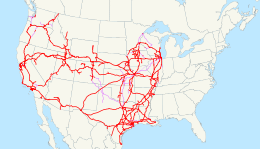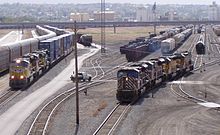Dec 30, 2015| MHLnews
The war of words between the top management of Canadian Pacific and Norfolk Southern intensified before the holidays just after the NS board of directors unanimously rejected a third purchase offer made by CP. The verbal jousting included a CP press release attacking NS and other U.S. railroads for giving their employees Christmas off.
“Our economy runs year round and shippers must be able to get their goods to market in a timely fashion, regardless of the date or the amount of snow on the ground,” says Keith Creel, CP president and chief operating officer.
The NS board had rejected two earlier bids of about $28 billion in cash and CP stock. CP then returned with a third offer that did not increase the cash component substantially but offered NS shareholders a bet on the combined railroads’ future. CP said it would pay NS investors up to $11.30 more per share if it turned out that the merged company shares were worth less than $175 each in October 2017.
NS stock rose to about $87 a share on Dec. 23, immediately following the NS board’s rejection of the third CP bid, and then dropped to just below $86 a share on Dec. 29. The rail company’s stock began the year around $110 a share and its 2015 low was about $72 at the end of August, before CP made its run at the company.
“It is apparent that neither the executive leadership at NS nor its board of directors are willing to sit down in an open and constructive dialogue about this transformational opportunity and that the interests of the NS board are not aligned with the best interests of NS shareholders,” CP declared in response to the NS board’s rejection of its third offer. “Therefore, CP will review its strategic alternatives,” the company added, without saying what those could be.
CP’s leading shareholder Bill Ackman claims NS management has failed to cut costs and make other operational changes needed to improve the railroad’s profitability. He said the same thing about CP when engineering its takeover, after which he slashed CP’s workforce by a third.
Ackman has said that if the NS merger ultimately fails, CP will possibly pursue acquiring other railroads, but didn’t delineate which ones.
CP Makes Bold Promises
CP says the combined railroads would be able to eliminate the Chicago chokepoint by routing trains around the city. CP also says that if the new company fails to provide adequate service or competitive rates, “it would allow another carrier to operate from a point of connection over the combined company’s tracks and into its terminals, providing an unprecedented alternative to the affected shipper.” How it would determine if service was inadequate and rates were noncompetitive was left unexplained.
NS chairman Jim Squires says the Chicago routing solution doesn’t exist. “Given the layout of the existing routes of both companies, Chicago is and would remain the primary connecting point between CP and NS. Less than one train per day of current CP and NS connecting traffic could be rerouted around the Chicago hub,” Squires said during a December investor call.
Squires and NS also have argued that CP is unlikely to achieve Surface Transportation Board approval of such a merger, which CP’s CEO Hunter Harrison admits could take up to two years. CP has proposed putting ownership of CP into a voting trust while it runs NS pending STB approval. For its part, NS’s Squires told CP it should go ahead and obtain approval from the STB for such a trust instead of waiting for the terms of a merger to be negotiated.
In mid-December 10 members of the Illinois congressional delegation, including Democrat Sen. Dick Durbin and nine members of the House, wrote the STB asking it to carefully consider the merger’s potential negative impact on building a more efficient freight network in Chicago.
In addition to the STB in the U.S., in Canada the transaction would need to pass muster with the administration of the new Prime Minister Justin Trudeau, which has given no indication how it views the current situation, although CP says it is confident the Canadian government would approve the merger.
However, it is difficult to believe that a Liberal government would look with particular favor on a company run by Americans who have already slashed 5,000 to 6,000 jobs and parked power units and other rolling stock which CEO Hunter Harrison has said eventually may be sold. In October Harrison said the railway could cut as many as 500 more jobs, including “some further cleansing of headquarters” staff.
Harrison, who is a Memphis, Tenn., native, may not have done his company’s cause much good in Canada by declaring immediately after the election that the Conservatives and prior Liberal governments hadn’t done much in the past to help the railway. “Just leave us alone, give us a level playing field and let us run our business,” he said.
Is CP Weaker Than It Seems?
Although CP says it is not done pursuing NS, it has stopped short of a hostile takeover bid that would require it to substantially boost the cash component of its offer to buy NS stock from shareholders. One reason is that CP has promised its lenders it will not push the offer to the point that it will endanger the company’s debt rating, Harrison admitted during a recent interview on the Bloomberg cable TV channel.
As of Dec. 28 it seemed unlikely that Ackman’s hedge fund, Pershing Square, would be able to contribute additional funds because it had lost an estimated 20% of its shareholders’ value, about $1.5 billion, by investing heavily in the Canadian pharmaceutical firm Valeant, currently under investigation for stock manipulation and overpricing its drugs, and which faces coming to terms with what some observers say is an unsustainable debt load.
This is not likely to bolster CP’s case with Canadian authorities. Neither is the knowledge that Ackman was reported last March to be under FBI investigation for his own possible stock manipulation in waging a negative publicity campaign against Herbalife and then shorting its stock.
Ackman’s attempts to turn around Valeant suffered another blow on Dec. 28 when the company announced its CEO was taking a leave of absence because of severe pneumonia, and that he would be replaced by a three-person senior management team. Valeant stock then took another nosedive apparently because of its lack of a succession plan that would have allowed a single executive to step into the CEO position.
CP may be facing a similar issue. During his recent Bloomberg interview Harrison was asked about the fact that he is 72 and by his own admission it could take up to two years for merger approval to be completed. He promised that he would stick around to see the deal and approval process through to conclusion, but surprisingly failed to use the opportunity to mention whether CP has a succession plan in place.
Perhaps they could start with “cleansing” the executive who thought it would be good public relations to put out a press release on Dec. 21 attacking the management of NS—along with Union Pacific and CSX Corp.—for allowing their employees to stay home with their families on Christmas.



























